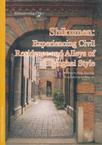石库门
2010-1
上海人民出版社
冯绍霆
174
李冰诗
无
I was extremely delighted to accept the job of writing the booklet when senior editor Su Yiming from Shanghai Peoples Publishing House approached me with the request. I was born and brought up in a Shikumen building, where I spent a total of 50 years. Most of my contact with my family, classmates and friends took place in Shikumen and ! should be counted as a Shikumen man. It was true that I had written about Shikmen before, but I still felt like saying more about them. Perhaps, people like me or those who have even more experience in Shikumen will find that the description in this book do not fully match the picture in their hearts. And to that, I can only say with regret that things are never the same when viewed from different perspectives. In hearts of ten thousand people, there are ten thousand views of Shikumen. I will be gratified if the readers simply agree that what the book describes is a real part of Shikumen. It is indeed a broad topic. As for those who have only a limited knowledge of Shikumen, I will feel greatly honored if the book helps them form even a rough impression.
This book gives a brief and vivid introduction of the architectural style, origin, changes and structural features of Shikumen. a type of unique civil residence in Shanghai. Apart from the customs and daily life of the people living in old Shanghai alleys, folklores and funny stories that happened behind black-painted gates, the author introduced anecdotes of celebrities and Shikumen in old Shanghai. new development of Shikumen ( such as Xintiandi), and also provided a guide to major scenic spots in Shikumen. The book helps its readers to gain a general knowledge of the unique civil residences in Shanghai, and to understand the influence of the living environment upon the characters of the Shanghai people that are most well known for their "shrewdness" and "meticulousness". The book is full of information, and. in a humorous and easy manner, presents to the readers with the knowledge and the history of Shikumen. It is easy to read and interesting, with a number of legendary and touching stories. Besides. it is pleasing to the eyes with many nice photos and historical pictures that lead one into a fascinating world.
Introduction: Shikumen, Shanghais TrademarkChapter One Shikumen: Time-honored Civilian Residence of Shanghai Style1.1 Shanghai was once a sea of Shikumen1.2 Shigumen or Shikumen?1.3 The origin of Shikumen1.4 The upgraded Shikumen1.5 The landlord1.6 The sublessor1.7 Dwellings of the immigrantsChapter Two Experiencing Shikumen Alleys2.1 Alley vendors in Lu Xuns works2.2 "Four Heavenly Guardians"—— special breakfast in old Shanghai2.3 Stalls of shoe-maker, hair dresser, pan repairer, and books2.4 Stores in the alleys2.5 Big businesses in small alleys2.6 Symphony of the alley2.7 Behind the black gate2.8 Traditional games in old alleysChapter Three A Place of Crouching Tigers: Anecdotes of Celebrities in Old Residence3.1 Chiang Kai-shek and Shikumen3.2 Where the red flag was raised3.3 Where the stars shone3.4 "Garret Writers"Chapter Four The New Look of Shikumen4.1 "No Peeing Here!"4.2 Being shrewd about living conditions4.3 Trend of home exchange and renovation4.4 A reluctant farewell to old Shikumen4.5 Renewal of ShikumenChapter Five Snapshots of Shikumen5.1 "Red sacred place"—— Old and New Yuyangli5.2 "Stronghold of the underground battle"—— Shenchengli5.3 "The Upper Side" —— Xiafeifang5.4 "Cradle of celebrities"—— Wanyifang5.5 "Many a first"——Tangjialong5.6 A major spot of money shops —— Xingrenli5.7 A place covered with hardware shops—— Zundeli5.8 Former red-light district—— Huileli5.9 A Stronghold of Japanese secret agents—— Zhexingli5.10 An unfinished tourist map of ShikumenReferencesPostscript
Zou Taofen, the famous patriot, lived in No. 53 Wanyifang from 1930 to 1936. The building is now the Taofen Memorial. Quite a few other celebrities also used to live there: Hu Dunfu, famous mathematician and founder of Datong University, lived in building No. 13; Qian Xingcun, a notable writer with a rich collection, lived in building No. 38; Ding Ling, the famous writer, lived in No. 60, where she gave birth to her child with Hu Yepin and received the terrible news that her husband had been murdered. The name of Zhu Zhiyao might not be familiar to the people of todays Shanghai. He was once a man of great fame. Enterprises like Qiuxin Shipyard, Tongchang Textile Mill, and Tongchang Oil Plant were all founded by Zhu. After the 1911 Revolution, he became Chairman of the Labor Party of the Republic of China, which was founded by him and another famous socialist, Xu Qiwen, who served as the Vice Chairman and was later killed by Yuan Shikai. Zhus fame didnt stem merely from his identity as a devout Catholic. His ancestors had been faithful Catholics since the late Ming Dynasty and early Qing Dynasty, and so were his relatives. His uncle was Ma Xiangbo, who founded Zhendan University and later Fudan University. After the Opium War, the Catholic Church built Dongjiadu Cathedral in Shanghai. The Zhu family moved to live next to the Cathedral and was known as the Zhu family of Dongjiadu. In 1946, Zhu Zhiyao spent his fortune on almsgiving—— a Catholic concept whose Buddhist equivalent is "making a contribution" and is often known to people as "doing good deeds".

无